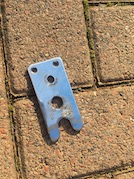With the “wedding hire” over, I can start thinking about investigating this oily No 7 spark plug. Sometime in December, I carried out a compression test on all 8 cylinders, and that showed that compressions were ok, and within a very small margin of each other. So far so good…
I then decided to carry out a leak down test on No 7 cylinder, to see if there’s any leak under compression. First step is to get No 7 cylinder at Top Dead Centre on its compression stroke. I take off the valve cover so that I can watch the valves opening and closing so that I know where “compression” is. Then by watching the crankshaft pulley while I turn it with a spanner, and using a screwdriver in the plug hole, I get it to TDC.
Then I connect up a leak down tester to the plug hole, fire up the compressor at around 15psi, and open the tester. It drops very slightly, but stays there, right in the green “ok” are of the gauge.
I then go round listening for any sound of escaping air. There’s a slight hiss from the oil filler, which is air passing the piston rings. Piston rings don’t seal against air, as well as they do against oil! So I’m not too worried about that.
I listen to the carb intake. Nothing. I listen to the exhaust. Nothing. No valve leaks then.
No air or bubbles in the coolant. Not a head gasket either, probably.
The leak down tester still reads the same - no bad leakage.
So how is oil getting into that cylinder? Well, since it seems to be worse after long periods of idling, that only seems to leave the valve stem seals, probably the inlet.
I go to order a set of valve stem seals, but they come in different sizes depending on the stem diameter. Of course, it couldn’t ever be that simple, could it?
So I measure the stems with a vernier. 6 of them are the same size (exactly right for an engine of this age). 2 of them are slightly bigger (exactly right for an engine of a different age). The odd 2 are on No 7 cylinder. Hmmm… the difference is only 7 thou or something, so I smell “bodge”. Has the car had new guides on that cylinder in the past? Or has somebody put 2 valves in, the wrong size? Who knows?
I order a set of valve stem seals from a really helpful guy in England. And today, finally, I’m going to fit them!
The first step is to remove the valve cover again, and with the engine turned so that the No 7 valves are both closed (ie on compression), I remove the rockers and the push rods, noting carefully which one goes where.
I then turn the engine forward half a turn so that No 7 piston is at the bottom of its stroke, and feed some 6mm rope into the plug hole. Then I turn the engine forwards to compress the rope against the bottom of the valves, so that they don’t fall through into the cylinder when I take the valve springs off.
I also ordered one of those valve spring compressors that let you remove the valve springs without taking off the cylinder head. Wish I hadn’t bothered - I can’t get it onto the spring because the servo is in the way, and I’m not dismantling the brakes to do this. I need a different way to compress the valve springs…
 And here it is, made from an old kitchen cabinet bracket. The central hole goes over the rocker stud, and the prongs go on top of the valve, either
side of the valve stem.
And here it is, made from an old kitchen cabinet bracket. The central hole goes over the rocker stud, and the prongs go on top of the valve, either
side of the valve stem.
I fit this wonder of technology onto the inlet valve rocker, with a socket between the “blunt end” and the cylinder head, and some washers as spacers on the rocker stud. Then I screw down the rocker bolt, remove the collets, let the bolt back up again and the valve spring is off!
There are two seals on each valve. First, an o-ring on the top, under the collets. I pull that off, then I can pry the other “umbrella” seal off the cylinder head with a screwdriver. Then I fit the new umbrella seal over the valve stem, and push it down into position. Then I fit the new o-ring on the top of the valve, put the spring back on, and re-assemble the compressor.
Getting the collets back in is a lot more fiddly that getting them out, because it’s difficult to keep the spring straight, and the collet gap even. Eventually I manage it though!
Repeat process for exhaust spring, then turn the engine back half a turn to extract the rope. Then turn the engine forward one full turn so that the camshaft in the right place for the valves on No 7 cylinder to be “on the rock” for adjustment.
Then I reassemble the push rods, rocks and bolts, and adjust the clearances to a “cold” setting before I refit the valve cover and spark plug.
It starts! And it sounds ok! I let it warm up for a bit, before I remove the cover and re-adjust those valves.